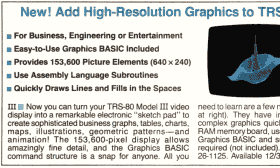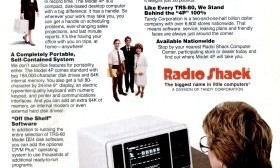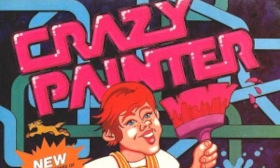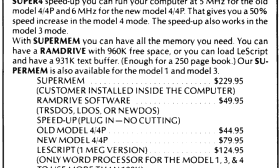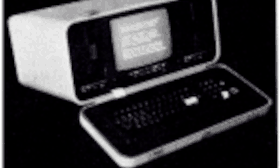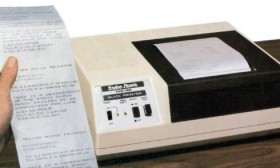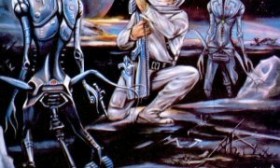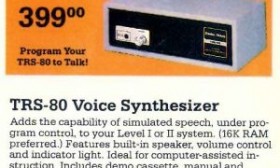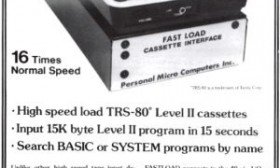Radio Shack introduced their high-resolution add-on for the Model III (catalog number 26-1125) on December 30, 1982 for a price of $369.95. It was never identified by name in any Radio Shack catalog but the official name seems to have been “TRS-80 Computer Graphics Package.” Few ever used that name and it was commonly referred to as the “Radio Shack high-resolution board.”
The Model III high-resolution board offered a resolution of 640 by 240. This was the same resolution as the Model II high-resolution add-on that Radio Shack had introduced the previous year, but it was higher than the normal Model III resolution of 512 by 192. There were so many similarities to the Model II high-resolution add-on that I suspect it was the basis for the Model III version.
(Read more...)
The TRS-80 Model 4P (catalog number 26-1080) was a transportable version of the TRS-80 Model 4, released on November 15, 1983 for a starting price of $1799. This was $200 less than the price of a desktop Model 4 and $200 more than its nearest competitor, the transportable Kaypro II.
Advertised as “a microcomputer worth carrying about” the Model 4P was introduced this way in a 1984 Radio Shack catalog:
Now get the versatility of our popular TRS-80 Model 4 desktop computer in a compact system you can take anywhere! The Model 4P is easy to carry—and it’s small enough to stow in overhead luggage racks on planes, trains, or buses. It’s the perfect computer for our mobile society!
(Read more...)
Crazy Painter qualifies as one of the few completely unique TRS-80 games. It was written by Robert Pappas, author of the TRS-80 games Frogger and Bounceoids. Crazy Painter was released by the Cornsoft Group in 1982. In addition to the TRS-80 version, the Cornsoft Group also released a version of Crazy Painter in 1983, written by Charles Guy, for the TRS-80 Color Computer. But there was no connection to the 1983 BBC Micro game named Crazy Painter, which was sold by Superior Software.
The goal in Crazy Painter is to completely fill the screen using a paint roller. This is a lot harder than it sounds because various obstacles, including roaming dogs and snakes, show up to ruin what you have already painted and hinder your efforts. Unlike most other arcade style games at the time, Crazy Painter is completely non-violent (unless you consider painting to be violent).
(Read more...)
The Alpha Technology Supermem was one of the most popular memory expansion options for the TRS-80. Alpha Technology (not to be confused with the similarly named Alpha Products) introduced the Supermem in 1985 for the Model I, Model III, and Model 4 in four memory sizes:
(Read more...)
Before laptop computers, there were transportable computers. Transportable computers (sometimes known as “portables” or “luggables”) were smaller than ordinary microcomputers and could be quickly moved and set up at a new location. Unlike laptop computers (which had yet to be invented) transportable computers had no batteries and needed to be set up and plugged into an outlet before they could be used.
Starting around 1981, there was a trend toward transportable computers. The Osborne 1 (introduced in 1981) and Kaypro II (introduced in 1982) were notable examples of CP/M transportables. The Compaq Portable (introduced in 1983) was probably the most famous MS-DOS transportable and the product that created the Compaq brand.
The Adcock & Johnson Model 3000, introduced in the spring of 1982, was a third-party TRS-80 entry in the transportable market. The Model 3000 consisted of an actual TRS-80 Model III converted into a transportable computer, either as a factory conversion or as a kit.
(Read more...)
The TRS-80 Model I (originally known as the TRS-80 Microcomputer System) was introduced by Radio Shack on August 3, 1977. It was one of the first mass-marketed, fully-assembled microcomputers and quickly became the best-selling personal computer.
Yet despite continued demand, Radio Shack discontinued the Model I on January 1, 1981, slightly less than three and a half years after it was first introduced. The culprit was not customer demand (which remained high) but new radio interference regulations from the United States Federal Communications Commission (FCC) which took effect on that date.
(Read more...)
The TRS-80 Quick Printer (catalog number 26-1153) was an early TRS-80 printer sold by Radio Shack. Introduced in 1978 for a price of $499.00, the Quick Printer was actually a rebranded Centronics Microprinter P1.
Unlike the more common dot-matrix or daisy-wheel printers (such as the TRS-80 Line Printer or the Daisy Wheel Printer II), the Quick Printer was an “electrostatic” printer that required special aluminum-coated paper. Radio Shack sold a package of three rolls of the 4.75″ wide “aluminized electrostatic spool paper” (catalog number 26-1405) for $16.95.
(Read more...)
Panik was not based on any particular arcade game; as one advertisement described it: “It has a little of all arcade games built in, but is its own original game.” It was written by William Demas, author of three other games for the TRS-80:
- Scott Adams’ Adventure #12 (sold by Adventure International)
- Forbidden Planet (sold by Fantastic Software)
- Forbidden City (sold by Fantastic Software)
One of the advertisements for Panik contained this overview:
(Read more...)
The TRS-80 Voice Synthesizer (catalog number 26-1180) was a speech synthesizer unit sold by Radio Shack. Introduced in 1979 for a price of $399.00, the unit was only compatible with the TRS-80 Model I; Radio Shack never sold a TRS-80 Model III version.
The TRS-80 Voice Synthesizer plugged directly into the Model I expansion port and worked with both Level I and Level II BASIC systems. Like most voice synthesizers at the time, it worked by outputting words already broken into phonemes, or very small units of sound. It was described this way by the product introduction (under the headline of “Your TRS-80 Speaks!”):
(Read more...)
The FASTLOAD cassette interface used a novel (and patented) method of speeding up loading cassette programs on a TRS-80 Model I. By using a specially modified cassette recorder permanently in fast-forward mode (the equivalent of the fast-forward button always being pressed), FASTLOAD increased cassette loading speeds up to sixteen times to as high as 8000 baud. FASTLOAD was introduced in 1981 by Personal Micro Computers, Inc. (also known as PMC) for a price of $188.00. The modified CTR-41 cassette recorder, required to use FASTLOAD, cost $95.00. Personal Micro Computers also sold FASTLOAD as an option for their PMC-80 and PMC-81 Model I compatible computers.
The FASTLOAD cassette interface connected to the Model I I/O connector and used a built-in ROM to add a new cassette loading routine (mapped to the LOAD command), keyboard debounce routine, automatic key repeat, and a key click feature. Upon startup, a single SYSTEM command was required to enable the FASTLOAD interface routines.
(Read more...)
